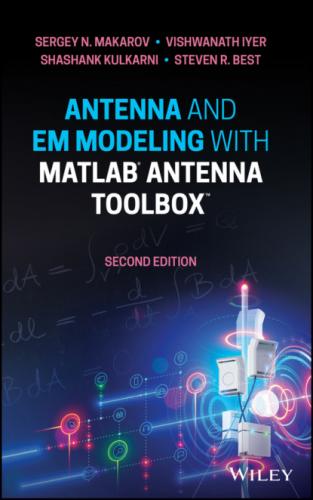7 Problems
1.8 ANTENNA REFLECTION COEFFICIENT FOR A LUMPED CIRCUIT
If an antenna is connected to the generator via a short cable with the length being small compared to the wavelength, the lumped circuit in Figure 1.3 is entirely sufficient for antenna modeling. In practice, however, the antenna is usually connected via a longer cable. The cable connections are also common in antenna arrays; they are used to construct the beamforming networks.
Voltage and currents on long cables (transmission lines) are in fact electromagnetic waves, which may propagate back and forth between the antenna and the generator. A method of scattering parameters or S‐parameters is useful in this case. S‐parameters describe the complete behavior of a high‐frequency distributed linear circuit. The term “scattering parameters” comes from the “Scattering Matrix” described in a 1965 IEEE article by K. Kurokawa entitled “Power Waves and the Scattering Matrix.” Today, S‐parameter results are displayed on the vector network analyzer display screen with the simple push of the button.
We will consider the lumped circuit in Figure 1.3 first, with a real generator impedance, Rg, and an arbitrary antenna impedance, Za. The ratio of the available power delivered to the antenna (1.13c) to the maximum available power (1.13d) for the ideal match gives us an important parameter, the normalized power delivered to the antenna:
(1.16)
This result is nicely expressed in terms of the complex reflection coefficient (or voltage reflection coefficient), Γ, which is given by a combination of generator and antenna impedances [1]:
The corresponding proof task is cast as a homework problem at the end of this chapter. Emphasize that, if the antenna is connected to a microstrip transmission line or a cable, then Rg is replaced by the characteristic impedance of the transmission line, Z0, i.e. Rg → Z0.
In the general case of generator(s) and load(s) connected by cables/transmission lines, whose length is comparable to the wavelength, the reflection coefficient is formed by two voltage or power waves [1]. The incident waveV+propagates along a cable (the transmission line) from the generator depicted in Figure 1.3‐left toward the antenna load. The reflected waveV−propagates along the same cable but in the opposite direction, i.e. from the antenna to the generator. The complete voltage solution is the sum of both. The complex reflection coefficient of the antenna with a cable is defined as the ratio of two complex voltage values at the generator,
If there is no reflected wave, the reflection coefficient is exactly zero and there is an ideal match in Eq. (1.17). The transmitted wave is completely acquired by the antenna and is then radiated into the surrounding space.
The meaning of transmitted and reflected power waves is extremely useful in measurements (the vector network analyzer) and specifically for modeling networks with transmission lines (cables) of a significant length where the electromagnetic waves can propagate in a nontrivial way (change the phase or decay).
The size of the lumped circuit in Figure 1.3 was assumed to be negligibly small compared to the wavelength. In this case, both contributions
Find
Solution: The “incident voltage wave” is the antenna voltage for the ideal match,
(1.19)
The “reflected voltage wave” is simply the actual antenna voltage minus the voltage for the ideal match, that is
(1.20)
Their ratio is given by
which is exactly Eq. (1.17). The reference plane (at either generator or the antenna load) does not matter for the lumped circuit.
1.9 ANTENNA REFLECTION COEFFICIENT WITH A FEEDING TRANSMISSION LINE
Now, consider a generator connected to the antenna through a lossless transmission line (a coaxial cable, a printed microstrip, or a waveguide). The familiar lumped circuit in Figure 1.7a (and Figure 1.3) is transformed as shown in Figure 1.7b. In many practical situations, the transmission line is precisely matched to the generator; its characteristic impedanceZ0 is chosen to be equal to the generator resistance, that is
(1.22)
